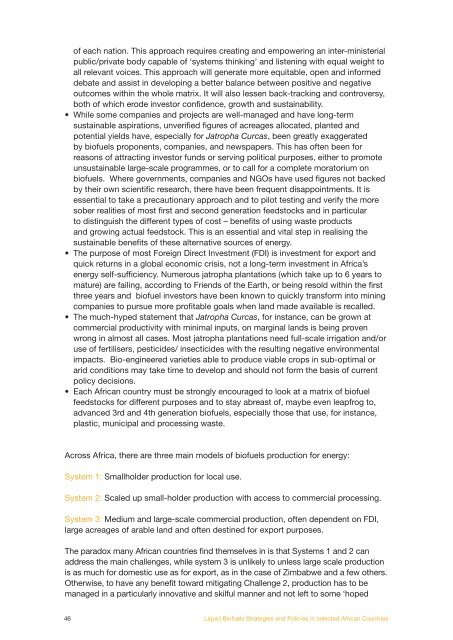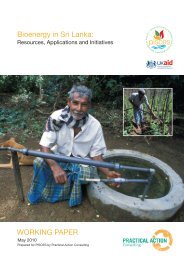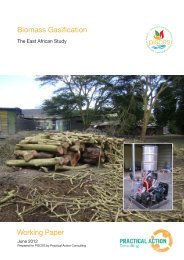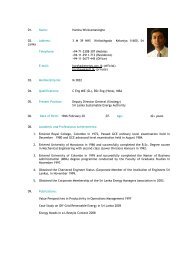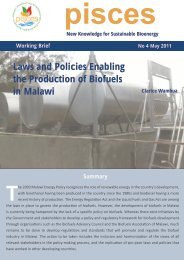Liquid Biofuels Strategies and Policies in selected African ... - Pisces
Liquid Biofuels Strategies and Policies in selected African ... - Pisces
Liquid Biofuels Strategies and Policies in selected African ... - Pisces
Create successful ePaper yourself
Turn your PDF publications into a flip-book with our unique Google optimized e-Paper software.
of each nation. This approach requires creat<strong>in</strong>g <strong>and</strong> empower<strong>in</strong>g an <strong>in</strong>ter-m<strong>in</strong>isterialpublic/private body capable of ‘systems th<strong>in</strong>k<strong>in</strong>g’ <strong>and</strong> listen<strong>in</strong>g with equal weight toall relevant voices. This approach will generate more equitable, open <strong>and</strong> <strong>in</strong>formeddebate <strong>and</strong> assist <strong>in</strong> develop<strong>in</strong>g a better balance between positive <strong>and</strong> negativeoutcomes with<strong>in</strong> the whole matrix. It will also lessen back-track<strong>in</strong>g <strong>and</strong> controversy,both of which erode <strong>in</strong>vestor confidence, growth <strong>and</strong> susta<strong>in</strong>ability.• While some companies <strong>and</strong> projects are well-managed <strong>and</strong> have long-termsusta<strong>in</strong>able aspirations, unverified figures of acreages allocated, planted <strong>and</strong>potential yields have, especially for Jatropha Curcas, been greatly exaggeratedby biofuels proponents, companies, <strong>and</strong> newspapers. This has often been forreasons of attract<strong>in</strong>g <strong>in</strong>vestor funds or serv<strong>in</strong>g political purposes, either to promoteunsusta<strong>in</strong>able large-scale programmes, or to call for a complete moratorium onbiofuels. Where governments, companies <strong>and</strong> NGOs have used figures not backedby their own scientific research, there have been frequent disappo<strong>in</strong>tments. It isessential to take a precautionary approach <strong>and</strong> to pilot test<strong>in</strong>g <strong>and</strong> verify the moresober realities of most first <strong>and</strong> second generation feedstocks <strong>and</strong> <strong>in</strong> particularto dist<strong>in</strong>guish the different types of cost – benefits of us<strong>in</strong>g waste products<strong>and</strong> grow<strong>in</strong>g actual feedstock. This is an essential <strong>and</strong> vital step <strong>in</strong> realis<strong>in</strong>g thesusta<strong>in</strong>able benefits of these alternative sources of energy.• The purpose of most Foreign Direct Investment (FDI) is <strong>in</strong>vestment for export <strong>and</strong>quick returns <strong>in</strong> a global economic crisis, not a long-term <strong>in</strong>vestment <strong>in</strong> Africa’senergy self-sufficiency. Numerous jatropha plantations (which take up to 6 years tomature) are fail<strong>in</strong>g, accord<strong>in</strong>g to Friends of the Earth, or be<strong>in</strong>g resold with<strong>in</strong> the firstthree years <strong>and</strong> biofuel <strong>in</strong>vestors have been known to quickly transform <strong>in</strong>to m<strong>in</strong><strong>in</strong>gcompanies to pursue more profitable goals when l<strong>and</strong> made available is recalled.• The much-hyped statement that Jatropha Curcas, for <strong>in</strong>stance, can be grown atcommercial productivity with m<strong>in</strong>imal <strong>in</strong>puts, on marg<strong>in</strong>al l<strong>and</strong>s is be<strong>in</strong>g provenwrong <strong>in</strong> almost all cases. Most jatropha plantations need full-scale irrigation <strong>and</strong>/oruse of fertilisers, pesticides/ <strong>in</strong>secticides with the result<strong>in</strong>g negative environmentalimpacts. Bio-eng<strong>in</strong>eered varieties able to produce viable crops <strong>in</strong> sub-optimal orarid conditions may take time to develop <strong>and</strong> should not form the basis of currentpolicy decisions.• Each <strong>African</strong> country must be strongly encouraged to look at a matrix of biofuelfeedstocks for different purposes <strong>and</strong> to stay abreast of, maybe even leapfrog to,advanced 3rd <strong>and</strong> 4th generation biofuels, especially those that use, for <strong>in</strong>stance,plastic, municipal <strong>and</strong> process<strong>in</strong>g waste.Across Africa, there are three ma<strong>in</strong> models of biofuels production for energy:System 1: Smallholder production for local use.System 2: Scaled up small-holder production with access to commercial process<strong>in</strong>g.System 3: Medium <strong>and</strong> large-scale commercial production, often dependent on FDI,large acreages of arable l<strong>and</strong> <strong>and</strong> often dest<strong>in</strong>ed for export purposes.The paradox many <strong>African</strong> countries f<strong>in</strong>d themselves <strong>in</strong> is that Systems 1 <strong>and</strong> 2 canaddress the ma<strong>in</strong> challenges, while system 3 is unlikely to unless large scale productionis as much for domestic use as for export, as <strong>in</strong> the case of Zimbabwe <strong>and</strong> a few others.Otherwise, to have any benefit toward mitigat<strong>in</strong>g Challenge 2, production has to bemanaged <strong>in</strong> a particularly <strong>in</strong>novative <strong>and</strong> skilful manner <strong>and</strong> not left to some ‘hopedfor’ trickle-down effect. While some countries may advocate for the creation of a policyframework that supports all three systems simultaneously, the choice between the threesystems, especially at the outset, is completely biased. In the perceived current globalfood, greenhouse gas <strong>and</strong> energy crises, the huge amounts of <strong>in</strong>ternational money for<strong>in</strong>vestment <strong>in</strong> the biofuels sector are focused almost exclusively on System 3.As po<strong>in</strong>ted out previously, a trillion dollars of aid has not brought agriculturaldevelopment or modern energy services to most of rural Africa. Much of the aidmoney, South-South technology transfer or benefits of large-scale <strong>in</strong>vestmentactivities, goes directly to, <strong>and</strong>/or is usually absorbed by, central governments.Multilateral donors such as the World Bank, <strong>and</strong> organisations such as REEEP, arefunded by governments <strong>and</strong> tend to engage with top-down approaches, such assupport<strong>in</strong>g national oil companies to drive the biofuels sector (e.g. Nigeria). So whilethe need is perhaps more desperate at the rural community level, <strong>and</strong> projects such asthe multifunction platforms (demonstrated <strong>in</strong> Tanzania) can beg<strong>in</strong> to make a difference,the scale of funds available for rural <strong>African</strong> energy self-sufficiency are extremelysmall compared with government to government <strong>in</strong>vestments or the current resourcesavailable to companies through <strong>in</strong>vestment funds.Ghana has taken the step of sett<strong>in</strong>g up a separate fund, <strong>and</strong> experts such as ThomasS<strong>in</strong>kala, Chairman of the <strong>Biofuels</strong> Association of Zambia, claim they only need240,000 hectares of biodiesel <strong>and</strong> ethanol feedstocks to make Zambia self-sufficient<strong>in</strong> energy, compared with 3-400,000 hectares lost to deforestation each year. Yet noone has yet had the foresight or <strong>in</strong>terest to fund Zambia’s proposed biofuels fund tocreate such a programme. There is no quick return on capital <strong>in</strong>vestment <strong>in</strong> creat<strong>in</strong>grural self-sufficiency <strong>and</strong> prevent<strong>in</strong>g Africa’s deforestation. Even relatively small-scaledonor <strong>and</strong> renewable energy ‘funds’, between $250,000-1,500,000, are dependent onrais<strong>in</strong>g matched capital, putt<strong>in</strong>g them beyond most small holder’s reach.In reality, System 3 is most likely to dom<strong>in</strong>ate, driven either centrally by nationalgovernments, such as <strong>in</strong> Zimbabwe <strong>and</strong> Nigeria, or through the allocation of hugeareas of l<strong>and</strong> to foreign companies to grow mono-crops for export, such as ishappen<strong>in</strong>g as part of government policies most openly <strong>in</strong> Ethiopia <strong>and</strong> Mozambique<strong>and</strong> to greater or lesser degrees across the rest of Africa. The majority of the <strong>African</strong>rural population does not have secure l<strong>and</strong> tenure, either through nationalised l<strong>and</strong>policies such as <strong>in</strong> Tanzania, Ethiopia, Mozambique <strong>and</strong> Zimbabwe, or throughhistorically weak national l<strong>and</strong> laws <strong>and</strong> implementation, (often orig<strong>in</strong>at<strong>in</strong>g fromcolonial times - such as <strong>in</strong> Kenya <strong>and</strong> not fully resolved s<strong>in</strong>ce).The worst case scenario is that, as Africa’s population <strong>in</strong>creases, much of Africa’sprime arable l<strong>and</strong> <strong>and</strong> much of its forests will be virtually h<strong>and</strong>ed over to nationalisedor <strong>in</strong>ternational large scale corporations to create large, often mechanised mono-crop(food <strong>and</strong> biofuels) plantations, with <strong>in</strong>tensive agricultural practices, that:1. Only employ a small portion of the exist<strong>in</strong>g (displaced) rural population as lowwaged or virtually bonded labourers.2. Displace rural populations <strong>in</strong>to unmanaged <strong>and</strong> sometimes unrecognised urbanslums (that can also ferment political dissent <strong>and</strong> unrest) lead<strong>in</strong>g to <strong>in</strong>creasedpoverty <strong>and</strong> <strong>in</strong> some cases <strong>in</strong>creas<strong>in</strong>gly dictatorial <strong>and</strong> militarised regimes.3. Lead to serious food shortages, fam<strong>in</strong>e <strong>and</strong> <strong>in</strong>flation, especially dur<strong>in</strong>g the<strong>in</strong>creas<strong>in</strong>g number of drought years.4. Increase deforestation, pollution, water shortages <strong>and</strong> greenhouse gas emissions46 <strong>Liquid</strong> <strong>Biofuels</strong> <strong>Strategies</strong> <strong>and</strong> <strong>Policies</strong> <strong>in</strong> <strong>selected</strong> <strong>African</strong> Countries <strong>Liquid</strong> <strong>Biofuels</strong> <strong>Strategies</strong> <strong>and</strong> <strong>Policies</strong> <strong>in</strong> <strong>selected</strong> <strong>African</strong> Countries 47


